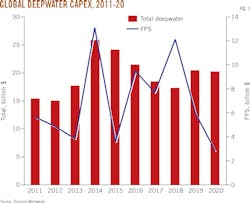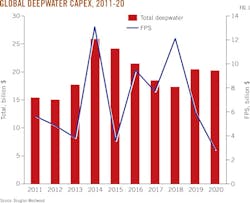Sustained low oil price subdues deepwater spend 2016-20
Mark Adeosun
Douglas-Westwood
Faversham, UK
Low oil prices will continue to impact deepwater capital expenditure (capex) over the next 5 years. Industry headlines have been dominated for the past 12 months by implications of the sustained downturn and operators have responded by announcing widespread redundancies, reducing budgets, and deferring new projects. Capex reductions were already a focus for operators before the oil price collapse, but have risen in importance in recent months. The market downturn has prompted the industry to rethink development processes with an increased focus on subsea equipment standardization, supply chain efficiency, and project simplification.
Despite near-term concerns, the long-term fundamentals for deepwater activity remain strong. As production from mature onshore and shallow-water basins declines, development of deepwater reserves becomes more important. The need to offset declining production from matured basins, as well as the ability of international oil companies (IOC) to access larger reserves with the use of new exploration and production technology, will continue to drive deepwater expenditure.
Despite the extended nature of the current downturn, Douglas-Westwood (DW) has identified increased deepwater expenditure in basins away from the traditional areas of West Africa, Brazil, and the US Gulf. Fast-track development plans for large deepwater discoveries such as Eni's Zohr gas field offshore Egypt and ExxonMobil's Liza discovery offshore Guyana show that some capital intensive projects will be sanctioned in the current weak price environment. Development plans, however, will be implemented in phases.
DW forecasts deepwater capex, excluding floating productions systems (FPS) spend, to plummet from 2014's record levels until 2018, with a gentle upswing in 2019-20 (Fig. 1). The upswing will be driven by development of deepwater prospects in Brazil and the beginning of offshore activity in the East Africa gas basin.
The FPS market will see a similar drop in spend, but this will be most evident in the latter years of the forecast period. In 2015, the industry experienced the lowest number of deepwater FPS units ordered since 1996. Unit orders are expected to remain minimal for 2016. The longer lead times associated with FPS projects have insulated the market to date, as most 2017-18 installations were ordered in 2013-14.
Global market
Deepwater expenditure will decline at -6% compound annual growth rate (CAGR) 2016-20. Total expenditure of $137 billion for the period, however, will still be a 5% increase on the previous five-year period ($129.6 billion). Project delays have resulted in a slower growth profile than was expected a year ago.
In addition to low oil prices, reduced rig demand will impact capex growth over the forecast period. Before the downturn, record deepwater rig demand resulted in an unprecedented level of rig orders, creating a supply-demand imbalance. Drilling contractors now face plummeting day rates due to a combination of oversupply and reduced demand, with day rate suppression triggering delays and cancellations for new rigs and widespread stacking of deepwater rigs.
The market downturn has negatively impacted all regions, but the degree to which this is true varies based on ongoing and prospective projects. Through 2020, Africa and the Americas will account for 87% of total deepwater expenditure (Fig. 2).
Latin America
Spending in Latin America will make up 38% of total offshore capex, driven by the number of FPS units expected to be installed over the forecast period. Petroleo Brasileiro SA's (Petrobras) financial problems, however, are likely to result in constrained future expenditure on new units.
Mexico showed much initial promise after reform of its energy sector to allow foreign upstream participants, but recent interest in licensing rounds has been tempered by the prolonged low oil prices and widespread exploration activity is unlikely in the near term.
Petroleos Mexicanos (Pemex) expected production from its Lakach deepwater development in 2018, but this project has been suspended for at least 1 year due to budget cuts.
East Africa
East Africa will be the next key deepwater hub, with offshore installation activities in Tanzania and Mozambique commencing during the forecast period. Development of these gas basins is highly likely, as planning for these projects is well developed.
Anadarko has awarded onshore LNG contracts that will process gas reserves in Mozambique. The potential recovery of oil prices may also boost LNG-spot prices.
Other regions
Beyond Africa and the Americas, minimal deepwater activity is forecast. The majority of other capex is driven by a small number of projects such as Statoil SA's Aasta Hansteen (OGJ Online, Aug. 26, 2014) and Chevron Corp.'s Rosebank (OGJ Online, July 9, 2012). Cancellations and delays to individual projects within smaller regions can have a substantial impact on market outlook. For example, expenditure within the UK is highly dependent on Rosebank, but there have been numerous changes to contractual terms associated with the project, leading to uncertainty regarding development timelines. Additional delays to the project timeline will further impact deepwater spend, creating a large potential downside to total UK capex.
Over the forecast period, the fastest growth in capex is expected in Australasia (37% CAGR); although, the region will remain a comparatively small deepwater market.
North America will account for 18% of total capex through 2020. Spend in the region will decline by 24% compared to the preceding 5 years due to both prolonged delays in project final investment decisions and outright cancellations. Notable projects affected include BP PLC's Hopkins discovery and Murphy Oil Corp.'s Thunder Bird (OGJ Online, Dec. 3, 2015).
Offshore components
Drilling and completion is the largest segment of the deepwater market, with expenditure totaling $53 billion to 2020, an incremental increase from 2011-15. The majority of spend in this category is associated with subsea well completion. Africa will have the most (38%) deepwater subsea well completions over the next 5 years. Latin America, however, will account for the largest capex in this segment (40%) due to lengthier drilling and completion times.
FPS account for the second largest segment of expenditure, 28% of total capex. This sector is dominated by Brazil, which accounts for 52% of total spend. Floating production, storage, and offloading (FPSO) vessels make up almost 81% of forecast FPS spend.
Out of forecast FPSO installations 2016-20, 82% have already been sanctioned. These projects will prevent a total collapse of the FPS market in the near term, but low oil prices are causing operators to reevaluate the use of FPS in development plans. A clear example is Leviathan field in the Eastern Mediterranean; Noble Energy has abandoned its proposed FPS unit for a subsea tieback to a shallow-water fixed platform in a bid to further reduce development cost (OGJ Online, June 2, 2016).
Subsea equipment, including production hardware and subsea umbilicals, risers, and flowlines (SURF), jointly account for 27% of global expenditure through 2020. Subsea production hardware spend is driven by the number of development wells drilled. Africa is the largest market for subsea production hardware over the forecast period, both in terms of the number of units installed and capex. SURF expenditure will total $17 billion through the next 5 years.
Pipeline capex will account for 6% of spend over the forecast period, a 2% decline from the previous 5 years. Political disagreements between Russia and Turkey regarding Syria prompted cancellation of the Turkish Stream pipeline (OGJ Online, June 25, 2015), which had been expected to boost expenditure over the forecast period. Spending later in the forecast period will benefit from projects such as Sur de Texas-Tuxpan gas pipeline.
Near-term outlook
Original equipment manufacturers, vessel owners, and drilling contractors are likely to find the next few years difficult as project delays continue. Operators are expected to reengineer and reevaluate development plans of various projects to improve their economic viability. Lower drilling and equipment costs have so far provided limited upsides for project sanctioning.
In addition to low oil prices, the corruption scandal and financial difficulties experienced by Petrobras will restrict the state-owned company's spending plans for the foreseeable future. Deepwater capex growth offshore Brazil will be impacted beyond the forecast period.
In Africa, the breakup of the Nigerian National Petroleum Corp. (NNPC) highlights continued efforts to overhaul the country's oil and gas sector, however, the future of the country's long-awaited Petroleum Industry Bill remains unclear. Prolonged uncertainty and various regulatory bottlenecks between the state and IOCs have created a lull in Nigeria's oil development. Delays and low prices are also impacting several major deepwater projects in the region, such as Royal Dutch Shell PLC's Bonga SW-Aparo and Chevron's Nsiko.
The North American outlook is largely negative through 2020. Several deepwater projects have either been cancelled or delayed by reengineering. In contrast to other regions, however, North America is well positioned for recovery by the end of the forecast period due to existing infrastructure. Subsea-well tiebacks will likely be the preferred system for future developments. Project reengineering and various cost reduction exercises in North America will also allow for rapid response to future oil price recovery.
The author


